A Socio-Ecological System Analysis of Multilevel Water Governance in Nicaragua
Abstract
1. Introduction
2. Materials and Methods
2.1. Socio-Ecological System Framework
2.2. Identification of Actors
2.3. Data Collection
2.4. Data Analysis
3. Results
3.1. Legal Framework and Actors
3.2. Stakeholder Mapping
3.3. Socio-Ecological System Narratives
4. Discussion
5. Conclusions
Author Contributions
Funding
Conflicts of Interest
Appendix A
| A Socio-Ecological System Analysis of Multilevel Water Governance in Nicaragua |
|---|
| This interview aims to develop an analysis of perceptions regarding multilevel water governance in Nicaragua. On the basis of field research, a socio-ecological system (SES) framework was applied for an analysis of multilevel water governance in Nicaragua and relevant semantic relationships. |
| Subject ID: GS___-___ |
| Key questions for the identification of variables in the application of the socio-ecological system (SES) framework. |
| 1. Is your institution/organization: ○decentralized, ○deconcentrated, ○autonomous, ○NGO, ○community-based |
| 2. Does your country have a modern water law? |
| 3. Is the Nicaraguan Water Law being implemented? ○Yes, specify: ○fully, ○partially ○No |
| 4. What are the main constraints for the implementation of the Nicaraguan Water Law? |
| 5. Is your institution/organization involved in major decision-making on water resources management? |
| 6. Is there overlap between the duties of different water resources management institutions/organizations? |
| 7. Are there “conflict resolution” mechanisms in water resources management? ○Yes, specify: ○between users, ○between users and institutions ○No |
| 8. Is there coordination between national-level organizations and your institution/organization in terms of water resources management? |
| 9. Are regulation/planning/implementation/financing processes in the sector part of a coherent approach, or are they ad hoc? |
| 10. How is your institution/organization financed? |
| 11. How is the allocation of financial resources for water management at your institution/organization? ○High, ○medium, ○low |
| 12. What does your institution/organization need to collaborate in terms of water governance at the local level? |
| 13. Are there processes for citizen participation on water policies and/or plans in your locality? |
| 14. Do participatory processes reflect the will of your local citizens? |
| 15. Are local participatory processes taken into account by national-level authorities in the formulation, evaluation, and elaboration of water resources programs and projects? |
| 16. Are you aware of any IWRM project in your locality? |
| 17. Does your institution/organization have specialized technicians for water resources issues? |
| 18. If your institution has specialized water technicians, do they specifically work on water issues or do they have other unrelated functions? If so, why? |
| 19. How would you rate access to information related to water resources? ○Bad, ○medium, ○good, ○excellent |
| 20. Are there water-related institutions in your locality? |
| 21. Are there conflicts of interests in terms of water resources management in your locality? If so, what do you associate them with? |
| ID | Municipality | Department | River Basin | River Basin Code [98] |
|---|---|---|---|---|
| Local Government Officer (GS1-1) | Jinotepe | Carazo | Between Brito River and Tamarindo River/San Juan River | 68 |
| Local Government Officer (GS1-2) | Diriamba | Carazo | Between Brito River and Tamarindo River | 68 |
| Local Government Officer (GS1-3) | Villanueva | Chinandega | Río Negro/Estero Real | 58/60 |
| Local Government Officer (GS1-4) | Chinandega | Chinandega | Estero Real/Between Cosigüina Volcano and Tamarindo River | 60/64 |
| Local Government Officer (GS1-5) | Chichigalpa | Chinandega | Between Cosigüina Volcano and Tamarindo River | 64 |
| Local Government Officer (GS1-6) | El Viejo | Chinandega | Estero Real/Between Estero Real and Cosigüina Volcano/Between Cosigüina Volcano and Tamarindo River | 60/62/64 |
| Local Government Officer (GS1-7) | Cinco Pinos | Chinandega | Estero Real | 60 |
| Local Government Officer (GS1-8) | Somotillo | Chinandega | Río Negro/Estero Real | 58/60 |
| Local Government Officer (GS1-9) | San Francisco del Norte | Chinandega | Estero Real | 60 |
| Local Government Officer (GS1-10) | Posoltega | Chinandega | Estero Real/Between Cosigüina Volcano and Tamarindo River | 60/64 |
| Local Government Officer (GS1-11) | Estelí | Estelí | Coco River/Río Negro/Estero Real/San Juan River | 45/58/60/69 |
| Local Government Officer (GS1-12) | La Trinidad | Estelí | San Juan River | 69 |
| Local Government Officer (GS1-13) | San Nicolás | Estelí | Coco River/San Juan River | 45/69 |
| Local Government Officer (GS1-14) | Condega | Estelí | Coco River | 45 |
| Local Government Officer (GS1-15) | Pueblo nuevo | Estelí | Coco River/Río Negro | 45/58 |
| Local Government Officer (GS1-16) | San Juan de Limay | Estelí | Coco River/Río Negro | 45/58 |
| Local Government Officer (GS1-17) | El Sauce | León | Estero Real/San Juan River | 60/69 |
| Local Government Officer (GS1-18) | León | León | Between Cosigüina Volcano and Tamarindo River | 64 |
| Local Government Officer (GS1-19) | Nagarote | León | Tamarindo River/Between Brito River and Tamarindo River/San Juan River | 66/68/69 |
| Local Government Officer (GS1-20) | Larreynaga | León | Estero Real/Between Cosigüina Volcano and Tamarindo River/San Juan River | 60/64/69 |
| Local Government Officer (GS1-21) | Telica | León | Estero Real/Between Cosigüina Volcano and Tamarindo River | 60/64 |
| Local Government Officer (GS1-22) | La Paz Centro | León | Between Cosigüina Volcano and Tamarindo River/Tamarindo River/San Juan River | 64/66/69 |
| Local Government Officer (GS1-23) | El Jicaral | León | San Juan River | 69 |
| Local Government Officer (GS1-24) | Santa Rosa del Peñón | León | Estero Real/San Juan River | 60/69 |
| Local Government Officer (GS1-25) | Achuapa | León | Río Negro/Estero Real | 58/60 |
| Local Government Officer (GS1-26) | Dipilto | Nueva Segovia | Coco River | 45 |
| Local Government Officer (GS1-27) | Ocotal | Nueva Segovia | Coco River | 45 |
| Local Government Officer (GS1-28) | Jalapa | Nueva Segovia | Coco River | 45 |
| Local Government Officer (GS1-29) | El Jícaro | Nueva Segovia | Coco River | 45 |
| Local Government Officer (GS1-30) | San Juan del Sur | Rivas | Between Brito River and Sapoá River | 72 |
| CAPS member (GS3a-1) | Dipilto | Nueva Segovia | Coco River | 45 |
| CAPS member (GS3a-2) | Dipilto | Nueva Segovia | Coco River | 45 |
| CAPS member (GS3a-3) | Dipilto | Nueva Segovia | Coco River | 45 |
| CAPS member (GS3a-4) | Dipilto | Nueva Segovia | Coco River | 45 |
| CAPS member (GS3a-5) | Dipilto | Nueva Segovia | Coco River | 45 |
| CAPS member (GS3a-6) | Dipilto | Nueva Segovia | Coco River | 45 |
| CAPS member (GS3a-7) | Dipilto | Nueva Segovia | Coco River | 45 |
| CAPS member (GS3a-8) | Estelí | Estelí | Coco River | 45 |
| CAPS member (GS3a-9) | Estelí | Estelí | Coco River | 45 |
| CAPS member (GS3a-10) | Chichigalpa | Chinandega | Between Cosigüina Volcano and Tamarindo River | 64 |
| Productive actor (GS3b-1) | Managua | Managua | San Juan River | 69 |
| Productive actor (GS3b-2) | Managua | Managua | San Juan River | 69 |
| Productive actor (GS3b-3) | Managua | Managua | San Juan River | 69 |
| Productive actor (GS3b-4) | Managua | Managua | San Juan River | 69 |
| Productive actor (GS3b-5) | Dipilto | Nueva Segovia | Coco River | 45 |
| Productive actor (GS3b-6) | Estelí | Estelí | Coco River/Río Negro/Estero Real/San Juan River | 45/58/60/69 |
| Productive actor (GS3b-7) | Estelí | Estelí | Coco River/Río Negro/Estero Real/San Juan River | 45/58/60/70 |
| Productive actor (GS3b-8) | León | León | Between Cosigüina Volcano and Tamarindo River | 64 |
| Productive actor (GS3b-9) | León | León | Between Cosigüina Volcano and Tamarindo River | 64 |
| Productive actor (GS3b-10) | Chichigalpa | Chinandega | Between Cosigüina Volcano and Tamarindo River | 64 |
| Basin Comm. Member (GS3c-2) | Dipilto | Nueva Segovia | Coco River | 45 |
| Basin Comm. Member (GS3c-1) | Estelí | Estelí | Coco River/Río Negro/Estero Real/San Juan River | 45 |
References
- Parello, F.; Aiuppa, A.; Calderon, H.; Calvi, F.; Cellura, D.; Martinez, V.; Militello, M.; Vammen, K.; Vinti, D. Geochemical characterization of surface waters and groundwater resources in the Managua area (Nicaragua, Central America). Appl. Geochem. 2008, 23, 914–931. [Google Scholar] [CrossRef]
- BCN. Nicaragua en Cifras 2014; Banco Central de Nicaragua: Managua, Nicaragua, 2015. [Google Scholar]
- IADB. Plan de Acción Managua Sostenible; Inter-American Development Bank: Managua, Nicaragua, 2013. [Google Scholar]
- LaVanchy, T.; Romano, S.; Taylor, M. Challenges to water security along the “Emerald coast”: A political ecology of local water governance in Nicaragua. Water 2017, 9, 655. [Google Scholar] [CrossRef]
- Fenzl, N. Nicaragua: Geografía, Clima, Geología y Hidrogeología; UFPA/INETER/UNAN: Managua, Nicaragua, 1999. [Google Scholar]
- Rogers, P.; Hall, A.W. Effective Water Governance; Global Water Partnership: Stockholm, Sweden, 2003; Volume 7. [Google Scholar]
- Asamblea Nacional de Nicaragua. Ley General de Aguas Nacionales; La Gaceta: Managua, Nicaragua, 2007. [Google Scholar]
- SEE Urban Water. Research Approach. 2018. Available online: https://www.tu-darmstadt.de/see-urban-water/intro/index.en.jsp (accessed on 13 May 2020).
- Ostrom, E. A general framework for analyzing sustainability of social-ecological systems. Science 2009, 325, 419–422. [Google Scholar] [CrossRef] [PubMed]
- McGinnis, M.D.; Ostrom, E. Social-ecological system framework: Initial changes and continuing challenges. Ecol. Soc. 2014, 19, 30. [Google Scholar] [CrossRef]
- Hinkel, J.; Bots, P.W.G.; Schlüter, M. Enhancing the Ostrom social-ecological system framework through formalization. Ecol. Soc. 2014, 19, 51. [Google Scholar] [CrossRef]
- Carlisle, K.; Gruby, R.L. Polycentric Systems of Governance: A Theoretical Model for the Commons. Policy Stud. J. 2019, 47, 927–952. [Google Scholar] [CrossRef]
- Hileman, J.; Lubell, M. The network structure of multilevel water resources governance in Central America. Ecol. Soc. 2018, 23, 48. [Google Scholar] [CrossRef]
- Petrosillo, I.; Aretano, R.; Zurlini, G. Socioecological systems. Ref. Modul. Earth Syst. Environ. Sci. 2015, 1–7. [Google Scholar] [CrossRef]
- Dressel, S.; Ericsson, G.; Sandström, C. Mapping social-ecological systems to understand the challenges underlying wildlife management. Environ. Sci. Policy 2018, 84, 105–112. [Google Scholar] [CrossRef]
- Schlüter, M.; Hinkel, J.; Bots, P.W.; Arlinghaus, R. Application of the SES framework for model-based analysis of the dynamics of social-ecological systems. Ecol. Soc. 2014, 19, 36. [Google Scholar] [CrossRef]
- Binder, C.R.; Hinkel, J.; Bots, P.W.; Pahl-Wostl, C. Comparison of frameworks for analyzing social-ecological systems. Ecol. Soc. 2013, 18, 26. [Google Scholar] [CrossRef]
- Palomo, L.E.; Hernández-Flores, A. Application of the Ostrom framework in the analysis of a social-ecological system with multiple resources in a marine protected area. PeerJ 2019, 7, e7374. [Google Scholar] [CrossRef] [PubMed]
- Hinkel, J.; Cox, M.E.; Schlüter, M.; Binder, C.R.; Falk, T. A Diagnostic Procedure for Applying the Social-Ecological Systems Framework in Diverse Cases. Ecol. Soc. 2015, 20, 32. [Google Scholar] [CrossRef]
- Ostrom, E. Background on the institutional analysis and development framework. Policy Stud. J. 2011, 39, 7–27. [Google Scholar] [CrossRef]
- Heikkila, T.; Andersson, K. Policy design and the added-value of the institutional analysis development framework. Policy Politics 2018, 46, 309–324. [Google Scholar] [CrossRef]
- Partelow, S. A review of the social-ecological systems framework. Ecol. Soc. 2018, 23, 36. [Google Scholar] [CrossRef]
- Weible, C.; Sabatier, P. Theories of the Policy Process; Routledge: Abington, UK, 2018. [Google Scholar]
- Novo, P.; Garrido, A. From policy design to implementation: An institutional analysis of the new Nicaraguan Water Law. Water Policy 2014, 16, 1009–1030. [Google Scholar] [CrossRef]
- Kuzdas, C.; Wiek, A.; Warner, B.; Vignola, R.; Morataya, R. Integrated and participatory analysis of water governance regimes: The case of the Costa Rican dry tropics. World Dev. 2015, 66, 254–268. [Google Scholar] [CrossRef]
- Corton, M.L.; Berg, S.V. Benchmarking Central American water utilities. Util. Policy 2009, 17, 267–275. [Google Scholar] [CrossRef]
- Beißler, M.R.; Hack, J. A combined field and remote-sensing based methodology to assess the ecosystem service potential of urban rivers in developing countries. Remote Sens. 2019, 11, 1697. [Google Scholar] [CrossRef]
- Serrano, M.; Ramos, P. Making Ostrom’s framework applicable to characterise social ecological systems at the local level. Int. J. Commons 2015, 9, 808–830. [Google Scholar] [CrossRef]
- Asamblea Nacional de Nicaragua. Decreto 68-2011 Creación de Unidades de Gestión Ambiental; La Gaceta: Managua, Nicaragua, 2001. [Google Scholar]
- Asamblea Nacional de Nicaragua. Ley Especial de Comités de Agua Potable y Saneamiento; La Gaceta: Managua, Nicaragua, 2010. [Google Scholar]
- Matschoss, K.; Repo, P. Governance experiments in climate action: Empirical findings from the 28 European Union countries. Environ. Politics 2018, 27, 598–620. [Google Scholar] [CrossRef]
- Primmer, E. Analysis of institutional adaptation: Integration of biodiversity conservation into forestry. J. Clean. Prod. 2011, 19, 1822–1832. [Google Scholar] [CrossRef]
- Bolognesi, T.; Kluser, S. Water security as a normative goal or as a structural principle for water governance. In A Critical Approach to International Water Management Trends; Springer: Berlin/Heidelberg, Germany, 2018; pp. 201–231. [Google Scholar]
- Hileman, J.; Bastos, M.T.; Lubell, M. Robustness and the paradox of bridging organizations: The exit problem in regional water governance networks in Central America. Soc. Nat. Resour. 2018, 31, 683–697. [Google Scholar] [CrossRef]
- Bodin, Ö.; Sandström, A.; Crona, B. Collaborative networks for effective ecosystem-based management: A set of working hypotheses. Policy Stud. J. 2017, 45, 289–314. [Google Scholar] [CrossRef]
- Katsou, E.; Nika, C.E.; Buehler, D.; Marić, B.; Megyesi, B.; Mino, E.; Almenar, J.B.; Bas, B.; Bećirović, D.; Đolić, S.B.M.; et al. Transformation tools enabling the implementation of nature-based solutions for creating a resourceful circular city. Blue-Green Syst. 2019, 2, 186–211. [Google Scholar] [CrossRef]
- Bengtsson, M. How to plan and perform a qualitative study using content analysis. Nurs. Open 2016, 2, 8–14. [Google Scholar] [CrossRef]
- Gumbo, B. The status of water demand management in selected cities of southern Africa. Phys. Chem. Earth Parts A/B/C 2004, 29, 1225–1231. [Google Scholar] [CrossRef]
- Calderon Palma, H. Surface and Subsurface Runoff Generation Processes in a Poorly Gauged Tropical Coastal Catchment; Delft University of Technology: TU Delft, The Netherlands, 2015. [Google Scholar]
- Campos, M.M. Design and Incorporation of Economic Incentives in Nicaraguan Policies to Improve the Efficiency of Water Consumption at the Industrial Level; Ohio University: Athens, OH, USA, 2011. [Google Scholar]
- Montenegro, L. Compendio Jurídico de Agua Potable y Saneamiento; CONAPAS: Managua, Nicaragua, 2008; p. 440. [Google Scholar]
- García, M.M.; Hileman, J.; Bodin, Ö.; Nilsson, A.; Jacobi, P.R. The unique role of municipalities in integrated watershed governance arrangements. Ecol. Soc. 2019, 24, 28. [Google Scholar] [CrossRef]
- OECD. Water Governance in OECD Countries; OECD: Paris, France, 2011. [Google Scholar]
- Zhang, Y.-F.; Thomas, M. Regulatory reform and governance: A survey of selected developing and transition economies. Public Adm. Dev. 2009, 29, 330–339. [Google Scholar] [CrossRef]
- Jonker, L. Integrated water resources management: The theory–praxis–nexus, a South African perspective. Phys. Chem. Earth Parts A/B/C 2007, 32, 1257–1263. [Google Scholar] [CrossRef]
- Van der Zaag, P. Asymmetry and Equity in Water Resources Management; Critical Institutional Issues for Southern Africa. Water Resour. Manag. 2007, 21, 1993–2004. [Google Scholar] [CrossRef]
- Agyenim, J.B.; Gupta, J. IWRM and developing countries: Implementation challenges in Ghana. Phys. Chem. Earth Parts A/B/C 2012, 47, 46–57. [Google Scholar] [CrossRef]
- Brown, E.; Cloke, J. Neoliberal reform, governance and corruption in Central America: Exploring the Nicaraguan case. Political Geogr. 2005, 24, 601–630. [Google Scholar] [CrossRef]
- Jonker, L. Integrated water resources management: Theory, practice, cases. Phys. Chem. Earth Parts A/B/C 2002, 27, 719–720. [Google Scholar] [CrossRef]
- Van der Zaag, P. Integrated Water Resources Management: Relevant concept or irrelevant buzzword? A capacity building and research agenda for Southern Africa. Phys. Chem. Earth Parts A/B/C 2005, 30, 867–871. [Google Scholar] [CrossRef]
- Vásquez, W.F. Municipal water services in Guatemala: Exploring official perceptions. Water Policy 2011, 13, 362–374. [Google Scholar] [CrossRef]
- Mutikanga, H.E.; Sharma, S.; Vairavamoorthy, K. Water loss management in developing countries: Challenges and prospects. Am. Water Works Assoc. 2009, 101, 57–68. [Google Scholar] [CrossRef]
- Mwendera, E.J.; Hazelton, D.; Nkhuwa, D.; Robinson, P.; Tjijenda, K.; Chavula, G. Overcoming constraints to the implementation of water demand management in southern Africa. Phys. Chem. Earth Parts A/B/C 2003, 28, 761–778. [Google Scholar] [CrossRef]
- Saleth, R.; Dinar, A. Institutional changes in global water sector: Trends, patterns, and implications. Water Policy 2000, 2, 175–199. [Google Scholar] [CrossRef]
- Metzgen, Y. BELIZE: National Integrated Water Resources Authority (NIWRA); Ministry of Natural Resources: Toronto, ON, Canada, 2014; p. 35.
- Ministry of Environment and Natural Resources. Organizational Structure. 2016. Available online: https://www.marn.gob.sv/ (accessed on 12 May 2020).
- Ministry of Environment and Natural Resources. Organizational Structure. 2015. Available online: http://www.marn.gob.gt/ (accessed on 12 May 2020).
- Ministry of Agriculture Livestock and Food. Organizational Structure. 2015. Available online: https://www.maga.gob.gt/ (accessed on 12 May 2020).
- Arrieta, L. Institucionalidad del agua en América Latina; Universidad Centroamericana José Simón Cañas: San Salvador, El Salvador, 2018; p. 106. [Google Scholar]
- Akhmouch, A. Water governance in Latin America and the Caribbean: A Multilevel Approach; OECD Publishing: Paris, France, 2012. [Google Scholar] [CrossRef]
- Secretary of Natural Resources and Environment. Dependencies. 2017. Available online: http://www.miambiente.gob.hn/ (accessed on 12 May 2020).
- Ministry of Environment and Energy. Organization Chart. 2019. Available online: https://www.minae.go.cr/ (accessed on 12 May 2020).
- Ministry of Environment. Analytical Flow Chart. 2020. Available online: https://www.miambiente.gob.pa/ (accessed on 12 May 2020).
- Trillas, F.; Montoya, M. The Degree of Commitment to Regulator Independence: Measurement and Impact. Hacienda Pública Española. 2008. Available online: https://www.ief.es/docs/destacados/publicaciones/revistas/hpe/185_Art4.pdf (accessed on 12 May 2020).
- Van Hofwegen, P.; Jaspers, F.G. Analytical Framework for Integrated Water Resources Management: IHE Monographs 2; CRC Press: Boca Raton, FL, USA, 1999; Volume 2. [Google Scholar]
- Gilardi, F. Delegation in the Regulatory State: Independent Regulatory Agencies in Western Europe; Université de Lausanne: Edinburgh, Scotland, 2003; pp. 1–38. [Google Scholar]
- Gonzalez, D. Productores se oponen a la ley que obliga a pagar por el agua/Farmers opossed to Water Tariff Law because they refuse to pay. In La Prensa; Editorial La Prensa: Managua, Nicaragua, 2017. [Google Scholar]
- Calero, M. País necesita ley de cánones para mejor aprovechamiento de sus aguas/ Country needs a Water Tariff Law for better use of its waters. In La Prensa; Editorial La Prensa: Managua, Nicaragua, 2017. [Google Scholar]
- Calero, M. Nicaragua necesita ley de cánones. In La Prensa; Editorial La Prensa: Managua, Nicaragua, 2016. [Google Scholar]
- Carlsson, L.; Berkes, F. Co-management: Concepts and methodological implications. J. Environ. Manag. 2005, 75, 65–76. [Google Scholar] [CrossRef]
- Gómez, L.I.; Ravnborg, H.M.; Hermann, R.R. Institucionalidad para la gestión del agua en Nicaragua; Nitlapan: Managua, Nicaragua, 2007. [Google Scholar]
- Leslie, H.M.; Basurto, X.; Nenadovic, M.; Sievanen, L.; Cavanaugh, K.C.; Cota-Nieto, J.J.; Erisman, B.E.; Finkbeiner, E.; Hinojosa-Arango, G.; Moreno-Báez, M.; et al. Operationalizing the social-ecological systems framework to assess sustainability. Proc. Natl. Acad. Sci. USA 2015, 112, 5979–5984. [Google Scholar] [CrossRef]
- Biswas, A.K. Integrated water resources management: Is it working? Int. J. Water Resour. Dev. 2008, 24, 5–22. [Google Scholar] [CrossRef]
- Castillo, E.; Calderón, H.; Delgado, V.; Flores, Y.; Salvatierra, T. Situación de los recursos hídricos en Nicaragua. Boletín Geológico y Minero 2006, 117, 127–146. Available online: https://repositorio.unan.edu.ni/2465/1/713.pdf (accessed on 14 May 2020).
- GWP Centroamérica. Situación de Los Recursos Hídricos en Centroamérica: Hacia una Gestión Integrada; Programa de Desarrollo de Zonas Fronterizas en América Central de la Unión: Tegucigalpa, Honduras, 2011; p. 147. [Google Scholar]
- Rural Water and Sanitation Information System. Improved Sanitation Coverage. 2020. Available online: http://www.siasar.org/es/paises/nicaragua (accessed on 25 May 2020).
- Areas, N. ENACAL discloses details of the national water resources plan. In El19Digital; Managua, Nicaragua, 2017. [Google Scholar]
- Asamblea Nacional de Nicaragua. Organic Law of the Attorney General of the Republic; La Gaceta: Managua, Nicaragua, 2001. [Google Scholar]
- Asamblea Nacional de Nicaragua. Criminal Code; La Gaceta: Managua, Nicaragua, 2008. [Google Scholar]
- World Bank. The World Bank in Nicaragua. 2020. Available online: https://www.worldbank.org/en/country/nicaragua/overview (accessed on 5 May 2020).
- Vanegas, M., Sr.; Gartner, W.; Senauer, B. Tourism and poverty reduction: An economic sector analysis for Costa Rica and Nicaragua. Tour. Econ. 2015, 21, 159–182. [Google Scholar] [CrossRef]
- GWP Centroamérica. Situation of Water Resources in Central America: Nicaragua; GWP Centroamérica: Tegucigalpa, Honduras, 2016; p. 45. [Google Scholar]
- Lacayo, R. Delimitation of Functions, Legal Analysis and Proposal for Interinstitutional Coordination; PROATAS-GIZ: Managua, Nicaragua, 2014; p. 53. [Google Scholar]
- Ingram, H. Beyond Universal Remedies for Good Water Governance: A Political and Contextual Approach. 6th Rosenberg Water Policy Forum. 2008. Available online: https://www.researchgate.net/publication/238658113 (accessed on 12 May 2020).
- Ravnborg, H.M.; Gómez, L.I. The Importance of Inequality for Natural Resource Governance: Evidence from Two Nicaraguan Territories. World Dev. 2015, 73, 72–84. [Google Scholar] [CrossRef][Green Version]
- Asamblea Nacional de Nicaragua. Constitución Política de la República de Nicaragua; La Gaceta: Managua, Nicaragua, 1987. [Google Scholar]
- Pacheco-Vega, R. Ostrom y la Gobernanza del Agua en México. Revista Mexicana de Sociología 2014, 76, 137–166. [Google Scholar] [CrossRef]
- Lubell, M. Governing institutional complexity: The ecology of games framework. Policy Stud. J. 2013, 41, 537–559. [Google Scholar] [CrossRef]
- Nagendra, H.; Ostrom, E. Applying the social-ecological system framework to the diagnosis of urban lake commons in Bangalore, India. Ecol. Soc. 2014, 19, 67. [Google Scholar] [CrossRef]
- Casiano Flores, C.; Özerol, G.; Bressers, H. “Governance restricts”: A contextual assessment of the wastewater treatment policy in the Guadalupe River Basin, Mexico. Util. Policy 2017, 47, 29–40. [Google Scholar] [CrossRef]
- Moss, T. Spatial fit, from panacea to practice: Implementing the EU Water Framework Directive. Ecol. Soc. 2012, 17. [Google Scholar] [CrossRef]
- Green, O.O.; Garmestani, A.S.; van Rijswick, H.F.; Keessen, A.M. EU water governance: Striking the right balance between regulatory flexibility and enforcement? Ecol. Soc. 2013, 18, 10. [Google Scholar] [CrossRef]
- Ching, L.; Mukherjee, M. Managing the socio-ecology of very large rivers: Collective choice rules in IWRM narratives. Glob. Environ. Chang. 2015, 34, 172–184. [Google Scholar] [CrossRef]
- Gupta, J. An Essay on Global Water Governance and Research Challenges. Princ. Good Gov. Differ. Water Gov. Levels 2011, 5. Available online: https://www.hydrology.nl/images/docs/ihp/nl/2011.03.22/2011.12_WaterGovernance.pdf#page=15 (accessed on 24 April 2020).
- Araral, E.; Wang, Y. Water governance 2.0: A review and second generation research agenda. Water Resour. Manag. 2013, 27, 3945–3957. [Google Scholar] [CrossRef]
- Akhmouch, A.; Clavreul, D. Stakeholder engagement for inclusive water governance:“Practicing what we preach” with the OECD water governance initiative. Water 2016, 8, 204. [Google Scholar] [CrossRef]
- Romano, S.T. Building Capacities for Sustainable Water Governance at the Grassroots: “Organic Empowerment” and Its Policy Implications in Nicaragua. Soc. Nat. Resour. 2017, 30, 471–487. [Google Scholar] [CrossRef]
- Ineter, A.; Uni, G.P. Cuencas Hidrográficas de Nicaragua bajo la Metodología Pfafstetter; INETER: Managua, Nicaragua, 2014; Available online: http://165.98.8.24/wordpresstest/wp-content/uploads/2016/07/Album-Cuencas-Nic-Revisado_ANA.pdf (accessed on 12 May 2020).
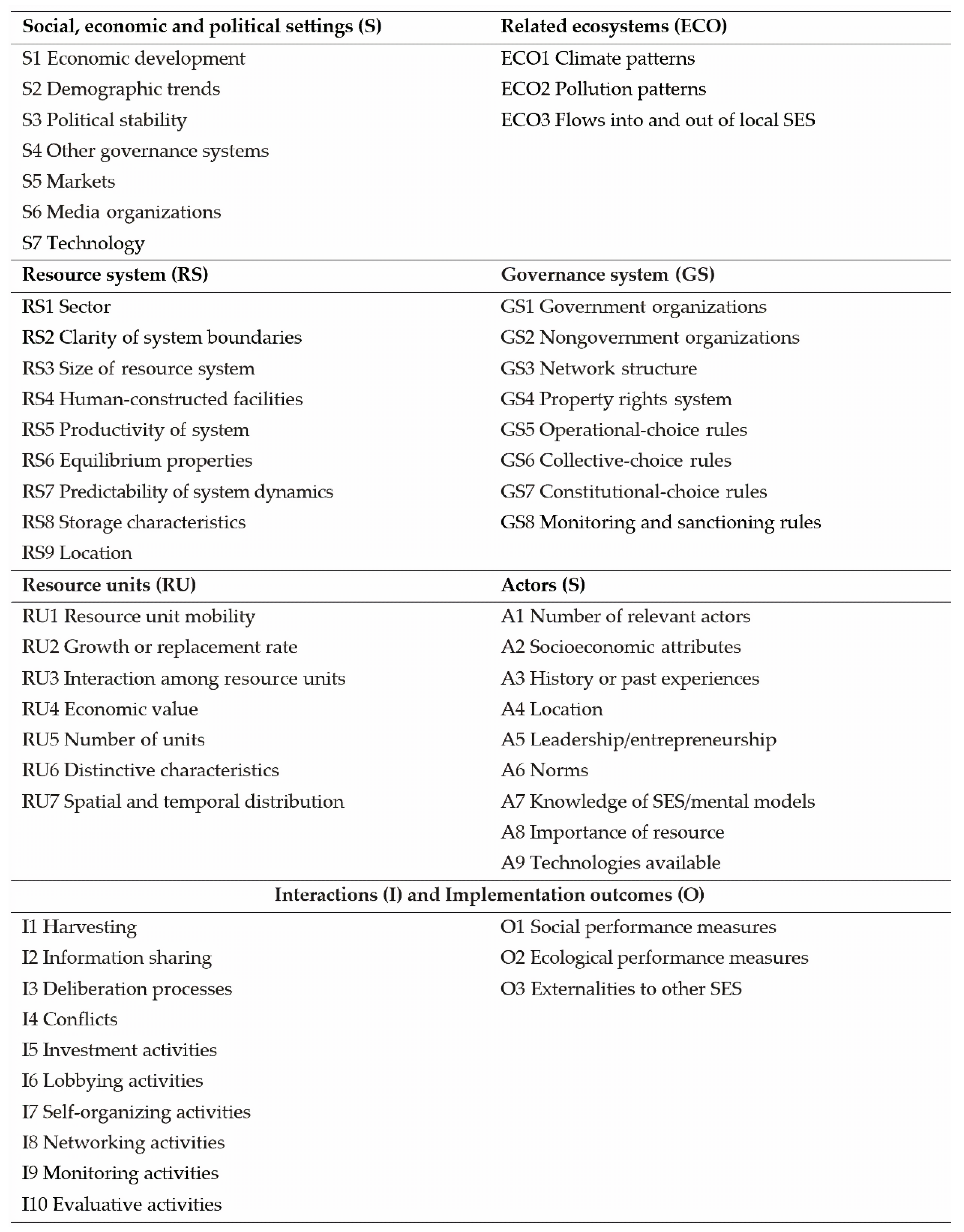
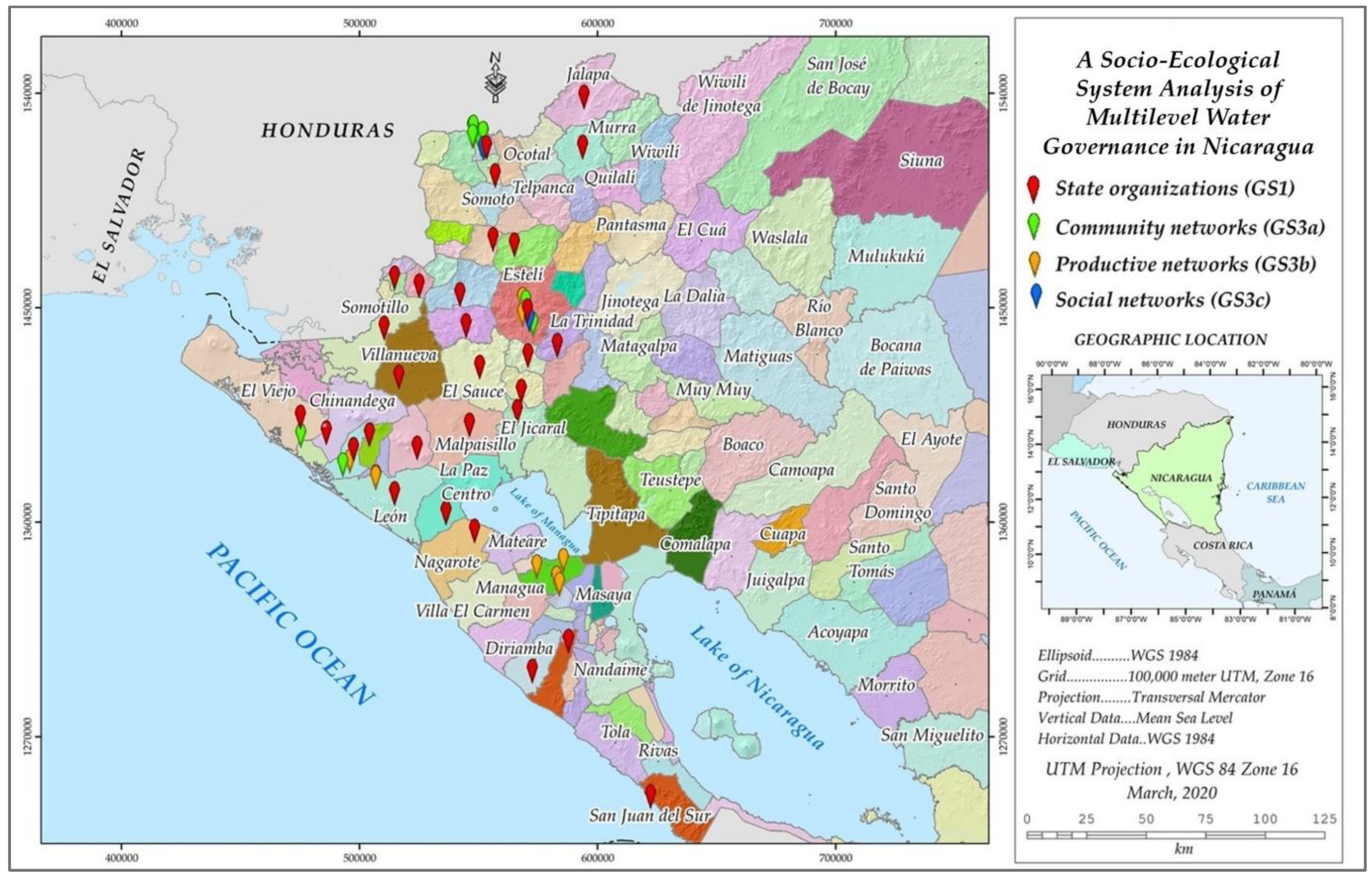
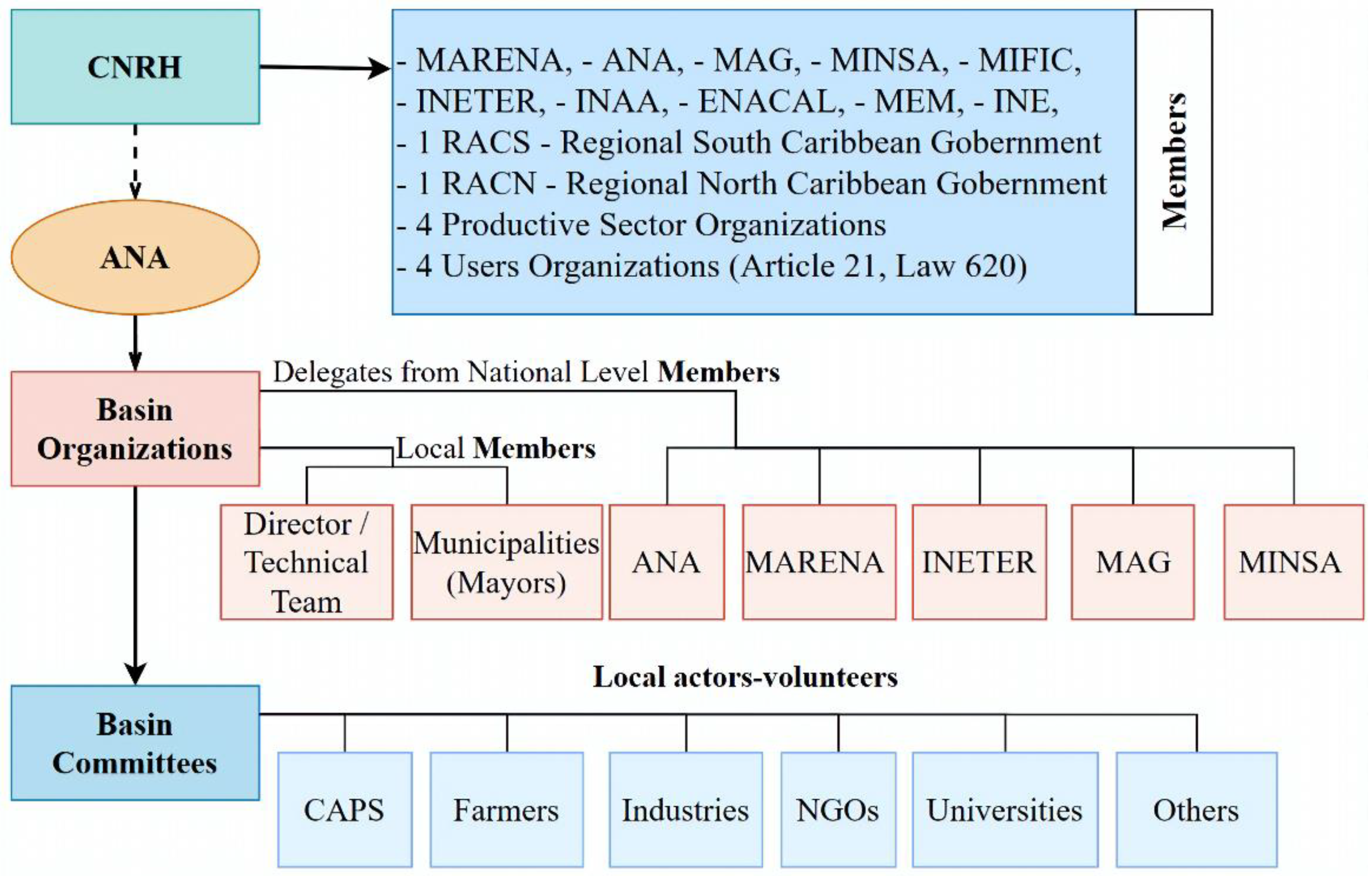
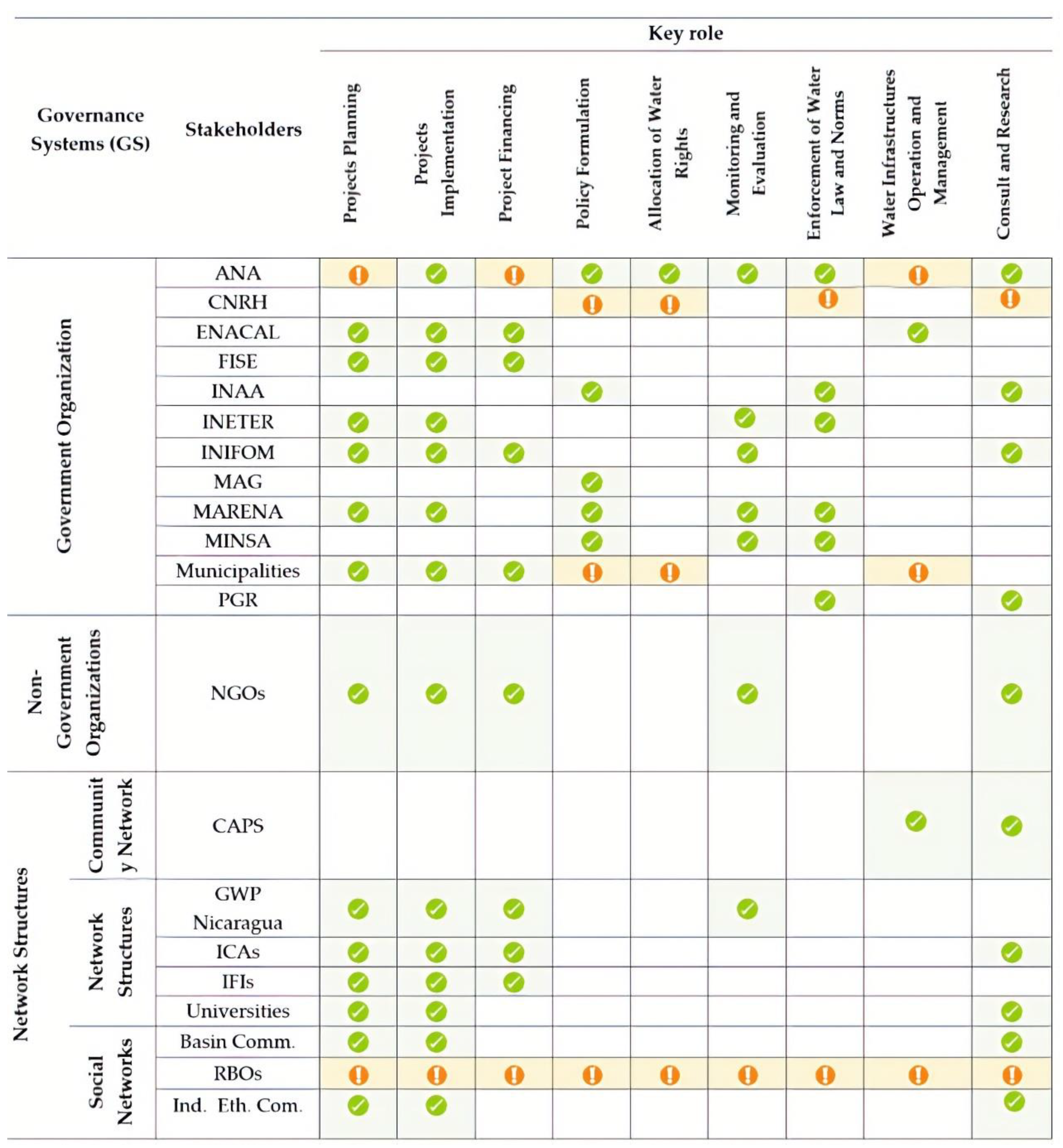
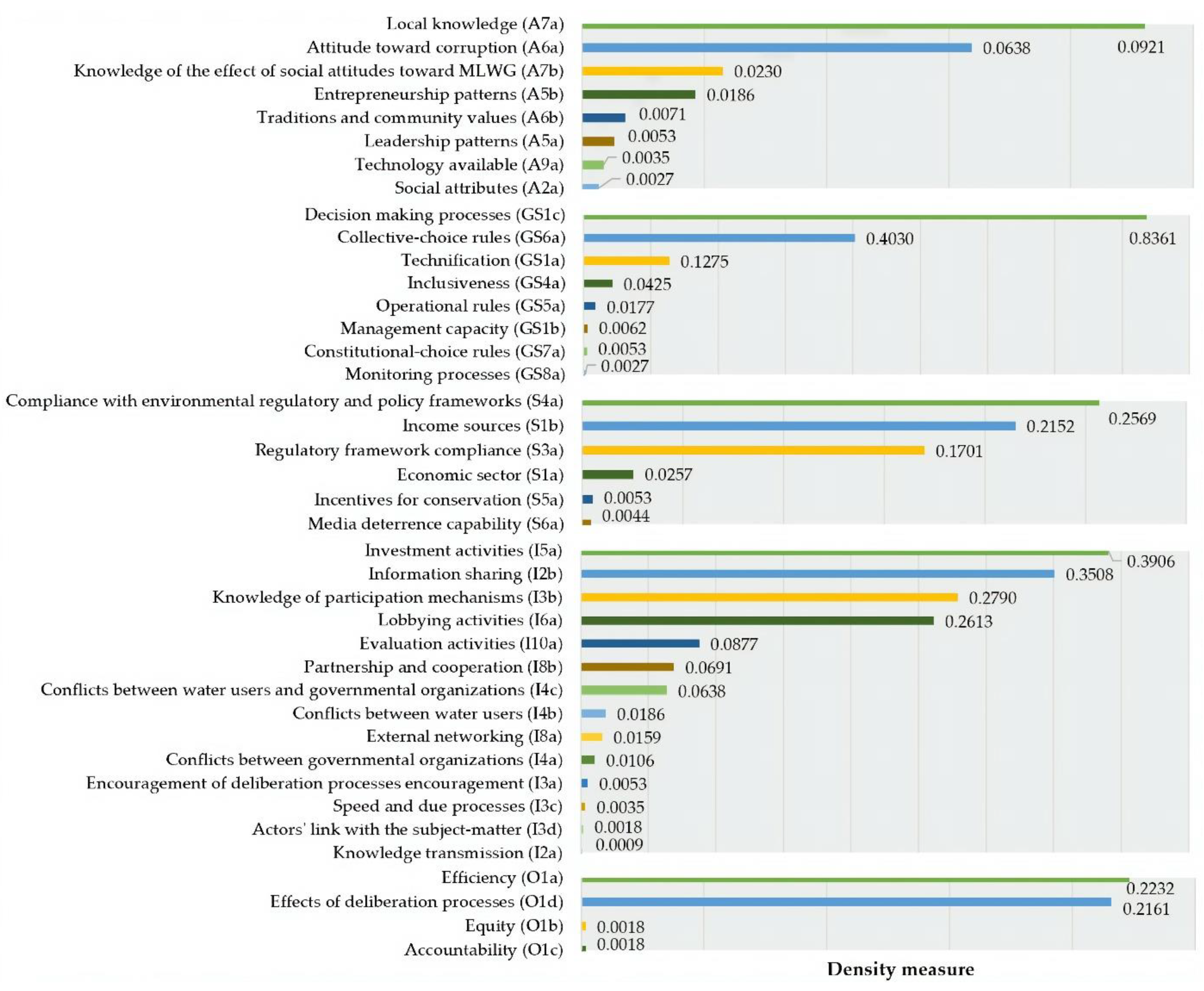
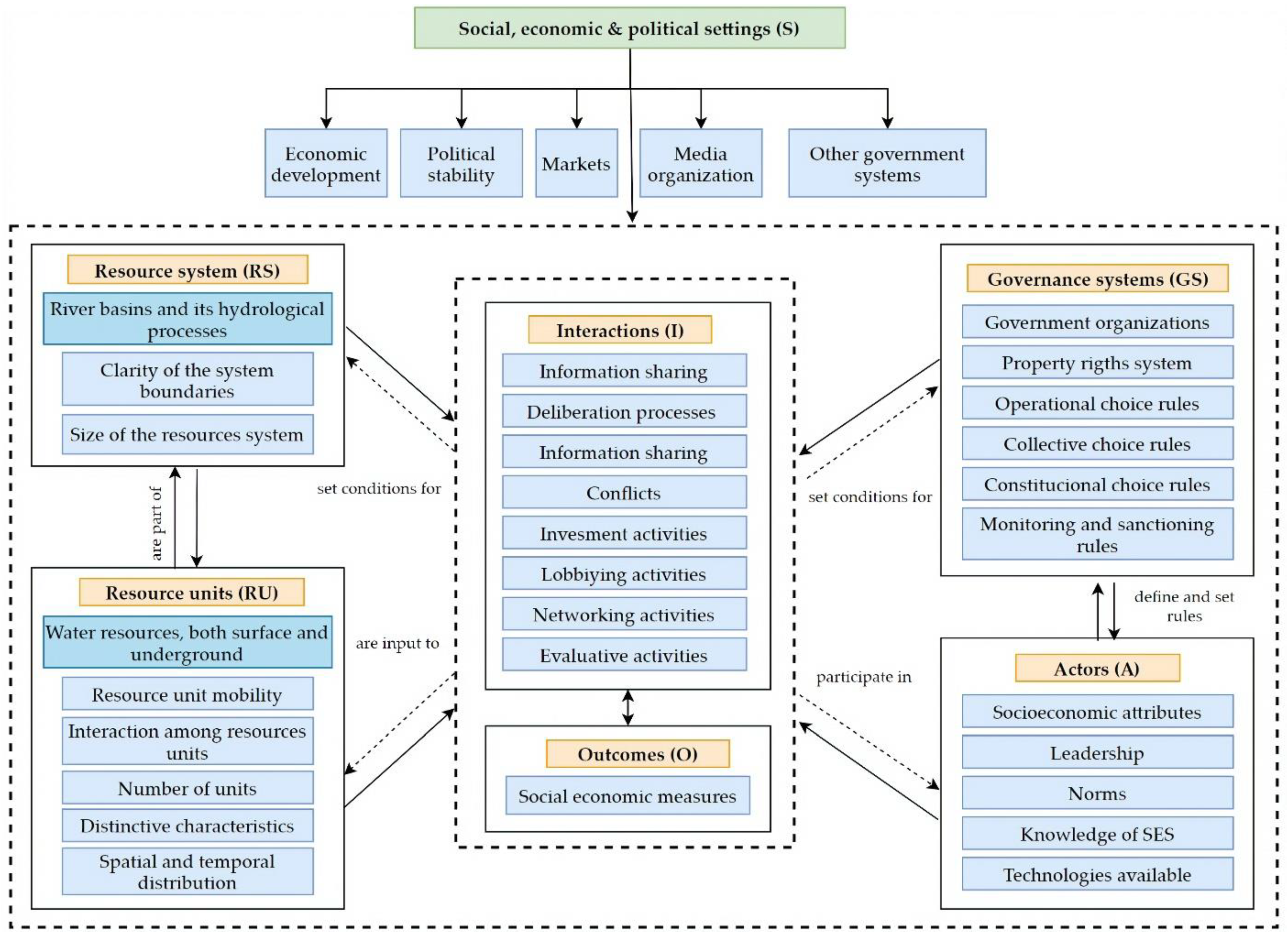
| Country | Institution | Dependency | Organization Type |
|---|---|---|---|
| Belize [55] | National Integrated Water Resource Authority | Independent regulatory agency | Decentralized |
| El Salvador [56] | General Directorate of Forest Management, River Basin, and Irrigation | Ministry of Environment and Natural Resources | Centralized |
| Guatemala [57,58] | Vice Ministry of Natural Resources and Climate Change/Vice-Ministry of Rural Economic Development | Ministry of Environment and Natural Resources/Ministry of Agriculture, Livestock and Food | Centralized |
| Honduras [59,60,61] | General Directorate of Water Resources | Secretary of Natural Resources and Environment | Centralized |
| Nicaragua [7,59] | National Water Authority | Independent regulatory agency | Decentralized |
| Costa Rica [62] | Directorate of Water | Ministry of Environment and Energy | Centralized |
| Panamá [63] | Directorate of Water Security | Ministry of Environment | Centralized |
| (a) | (b) | (c) | (d) | (e) |
|---|---|---|---|---|
| Second-Tier Variables | Working Definition | Third-Tier Variables | Operationalization of Variables | Question (Appendix A, Table A1) |
| (A2) Socio economic attributes | Socioeconomic characteristics affecting multilevel water governance | (A2a) Social attributes |
| 12 |
| (A5) Leadership/entrepreneurship | Stakeholder leadership and entrepreneurship patterns affecting multilevel water governance | (A5a) Leadership patterns |
| 7 |
| (A5b) Entrepreneurship patterns |
| 10 | ||
| (A6) Norms | Refers to rules set by good practices in society, integrating ethical and moral aspects | (A6a) Attitude toward corruption |
| 14, 21 |
| (A6b) Traditions and community values |
| 4, 7 | ||
| (A7) Knowledge of SES/mental models | Knowledge and understanding of SES components and their interaction effects | (A7a) Local knowledge |
| 2, 16 |
| (A7b) Knowledge of effects of social attitudes toward MLWG |
| 5, 6 | ||
| (A9) Technology available | Water management technology available and accessible | (A9a) Technology available |
| 12 |
| (a) | (b) | (c) | (d) | (e) |
|---|---|---|---|---|
| Second-Tier Variables | Working Definition | Third-Tier Variables | Operationalization of Variables | Question (Appendix A, Table A1) |
| (GS1) Government organizations | Government organizations at the local level have technical, administrative, and operational duties to protect common interests | (GS1a) Technification |
| 12, 17, 18 |
| (GS1b) Management capacity |
| 18 | ||
| (GS1c) Decision-making processes |
| 4, 5, 8, 9, 12, 20, 21 | ||
| (GS4) Property rights system | Rules defining actions and their relation to multilevel water management | (GS4a) Inclusiveness |
| 4, 8, 9, 12 |
| (GS5) Operational choice rules | Seated mechanisms and processes to take action in the water governance system at the local and national level | (GS5a) Operational rules |
| 4, 12 |
| (GS6) Collective choice rules | Mechanisms through which water governance rules are set by stakeholders | (GS6a) Collective choice rules |
| 4, 5, 13, 14 |
| (GS7) Constitutional choice rules | Legitimization of multilevel contributions to Nicaraguan constitutional framework and compliance | (GS7a) Constitutional choice rules |
| 4 |
| (GS8) Monitoring and sanctioning rules | Mechanisms and processes to monitor and sanction water management | (GS8a) Monitoring processes |
| 4 |
| (a) | (b) | (c) | (d) | (e) |
|---|---|---|---|---|
| Second-Tier Variables | Working Definition | Third-Tier Variables | Operationalization of Variables | Question (Appendix A, Table A1) |
| (S1) Economic development | Economic resources available in Nicaragua to guarantee multilevel water governance | (S1a) Economic sector |
| 4 |
| (S1b) Income sources |
| 10 | ||
| (S3) Political stability | Compliance with the functions and responsibilities of government organizations according to the Nicaraguan regulatory framework, in order to guarantee democratic processes | (S3a) Regulatory framework compliance |
| 6, 5, 3 |
| (S4) Other governance systems | Nicaraguan regulatory framework related to policies adopted in order to guarantee water governance | (S4a) Compliance with environmental regulatory and policy frameworks |
| 3, 4 |
| (S5) Markets | Markets for water strategies and conservation mechanisms | (S5a) Incentives for conservation |
| 12 |
| (S6) Media organization | Mechanisms to encourage the diffusion and implementation of water resource policies and strategies | (S6a) Media deterrence capability |
| 4 |
| (a) | (b) | (c) | (d) | (e) |
|---|---|---|---|---|
| Second-Tier Variables | Working Definition | Third-Tier Variables | Operationalization of Variables | Question (Appendix A, Table A1) |
| (I2) Information sharing | Mechanisms for information sharing among users, governmental organizations, nongovernmental organizations, network structures, and social and community networks | (I2a) Knowledge transmission |
| 19 |
| (I2b) Information sharing |
| 19 | ||
| (I3) Deliberation processes | Discussion and debate processes to analyze issues in water governance, integrating multiple actors and evaluating benefits and consequences prior to decision-making | (I3a) Encouragement of deliberation processes |
| 12 |
| (I3b) Knowledge of participation mechanisms |
| 7, 9, 12 | ||
| (I3c) Speed and due processes |
| 4 | ||
| (I3d) Actors’ link with the subject matter |
| 9 | ||
| (I4) Conflicts | Conflicts between water management stakeholders at the local and national level | (I4a) Conflicts between governmental organizations |
| 7, 12 |
| (I4b) Conflicts between water users |
| 21 | ||
| (I4c) Conflicts between water users and governmental organizations |
| 21 | ||
| (I5) Investment activities | Investment activities for the improvement of water management as a part of water governance | (I5a) Investment activities |
| 11, 12 |
| (I6) Lobbying activities | Capacity of users to coordinate lobbying activities, manage resources, and take decisions to a higher level | (I6a) Lobbying activities |
| 5, 9, 13 |
| (I8) Networking activities | Networking and partnership activities, coordination for water management | (I8a) External networking |
| 5, 7 |
| (I8b) Partnership and cooperation |
| 4, 5, 6, 12 | ||
| (I10) Evaluative activities | Reflective evaluation of effects due to activities carried out and decisions made related to water governance | (I10a) Evaluation activities |
| 9 |
| (O1) Social performance measures | Impacts of social components and concepts included | (O1a) Efficiency |
| 9, 16 |
| (O1b) Equity |
| 16 | ||
| (O1c) Accountability |
| 14 | ||
| (O1d) Effects of deliberation processes |
| 15, 19 |
© 2020 by the authors. Licensee MDPI, Basel, Switzerland. This article is an open access article distributed under the terms and conditions of the Creative Commons Attribution (CC BY) license (http://creativecommons.org/licenses/by/4.0/).
Share and Cite
Montenegro, L.; Hack, J. A Socio-Ecological System Analysis of Multilevel Water Governance in Nicaragua. Water 2020, 12, 1676. https://doi.org/10.3390/w12061676
Montenegro L, Hack J. A Socio-Ecological System Analysis of Multilevel Water Governance in Nicaragua. Water. 2020; 12(6):1676. https://doi.org/10.3390/w12061676
Chicago/Turabian StyleMontenegro, Luis, and Jochen Hack. 2020. "A Socio-Ecological System Analysis of Multilevel Water Governance in Nicaragua" Water 12, no. 6: 1676. https://doi.org/10.3390/w12061676
APA StyleMontenegro, L., & Hack, J. (2020). A Socio-Ecological System Analysis of Multilevel Water Governance in Nicaragua. Water, 12(6), 1676. https://doi.org/10.3390/w12061676







